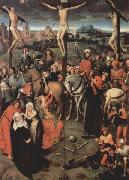Wholesale Oil Painting No Minimum |
|||||||||||
|
|
|||||||||||

|
|||||||||||
|
|
|
||||||||
Hans MemlingNetherlandish Northern Renaissance Painter, ca.1435-1494 Born in Seligenstadt, near Frankfurt in the Middle Rhein region, it is believed that Memling served his apprenticeship at Mainz or Cologne, and later worked in the Netherlands under Rogier van der Weyden (c. 1455?C1460). He then went to Bruges around 1465. There is an apocryphical story that he was a wounded at the Battle of Nancy, sheltered and cured by the Hospitallers at Bruges, and that to show his gratitude he refused payment for a picture he had painted for them. Memling did indeed paint for the Hospitallers, but he painted several pictures for them, in 1479 and 1480, and it is likely that he was known to his patrons of St John, prior to the Battle of Nancy. Memling is connected with military operations only in a distant sense. His name appears on a list of subscribers to the loan which was raised by Maximilian I of Austria, to defend against hostilities towards France in 1480. In 1477, when he was incorrectly claimed to have been killed, he was under contract to create an altarpiece for the gild-chapel of the booksellers of Bruges. This altarpiece, under the name of the Seven Griefs of Mary, is now in the Gallery of Turin. It is one of the fine creations of his more mature period. It is not inferior in any way to those of 1479 in the hospital of St. John, which for their part are hardly less interesting as illustrative of the master's power than The Last Judgment which can be found since the 1470s in the St. Mary's Church, Gda??sk. Critical opinion has been unanimous in assigning this altarpiece to Memling. This affirms that Memling was a resident and a skilled artist at Bruges in 1473; for the Last Judgment was undoubtedly painted and sold to a merchant at Bruges, who shipped it there on board of a vessel bound to the Mediterranean, which was captured by Danzig privateer Paul Beneke in that very year. This purchase of his pictures by an agent of the Medici demonstrates that he had a considerable reputation. |
||||||||
|
|
||||||||
Passion Altarpiece
Passion Altarpiece Painting ID:: 59894 |
Passion Altarpiece/Polyptych (1491) in L??beck Passion Altarpiece/Polyptych (1491) in L??beck |
|||||||
|
|
||||||||
|
unknow artist Passion Altarpiece 1490-95 Oak, 88,5 x 87,5 cm Museum Mayer van den Bergh, Antwerp Brabant workshops were world-famous in the 15th and 16th centuries for their carved and painted altarpieces. These works were not only designed for local use, they were exported all over Europe. Some altarpieces were extremely large, and only a few were produced on a miniature scale. This example in the Mater van den Bergh Museum is one of them. Small altarpieces of this kind were undoubtedly intended for private use. The little Passion altarpiece corresponds in form and style to the works produced in Brussels in around 1500. The mark of the Brussels joiners who made the case can still be seen, confirming the city of origin. It was once possible to close the altarpiece by means of painted wings. As so often, however, these have been lost. Nevertheless, the beautifully painted groups of carved figures tell us a great deal about the artistic talent of the painter and the rich colour scheme that must once have characterized the piece. , Artist: UNKNOWN MASTER, Flemish , Passion Altarpiece , 1451-1500 , Flemish , sculpture , religious |
||||||||
|
|
||||||||
|
Prev Next
|
||||||||
|
|
||||||||
|
Related Paintings to unknow artist :. |
||||||||
|
|
||||||||
|
CONTACT US |

